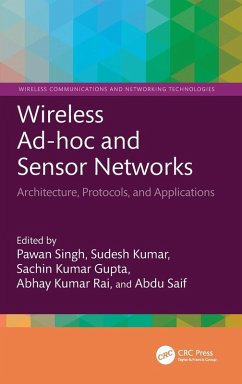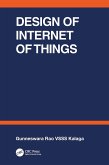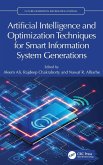Wireless Ad-hoc and Sensor Networks
Architecture, Protocols, and Applications
Herausgeber: Singh, Pawan; Gupta, Sachin Kumar; Kumar, Sudesh
Wireless Ad-hoc and Sensor Networks
Architecture, Protocols, and Applications
Herausgeber: Singh, Pawan; Gupta, Sachin Kumar; Kumar, Sudesh
- Gebundenes Buch
- Merkliste
- Auf die Merkliste
- Bewerten Bewerten
- Teilen
- Produkt teilen
- Produkterinnerung
- Produkterinnerung
The book explains the power, and routing optimization in underwater sensor networks, advanced cross-layer framework, challenges, security issues in underwater sensor networks, and the use of machine learning and deep learning techniques for security implementations in wireless ad-hoc and sensor networks.
Andere Kunden interessierten sich auch für
![Intelligent Networks Intelligent Networks]() Intelligent Networks193,99 €
Intelligent Networks193,99 €![Artificial Intelligence for Wireless Communication Systems Artificial Intelligence for Wireless Communication Systems]() Artificial Intelligence for Wireless Communication Systems155,99 €
Artificial Intelligence for Wireless Communication Systems155,99 €![Smart Agriculture Smart Agriculture]() Smart Agriculture97,99 €
Smart Agriculture97,99 €![Design of Internet of Things Design of Internet of Things]() Gunneswara Vsss Kalaga RaoDesign of Internet of Things154,99 €
Gunneswara Vsss Kalaga RaoDesign of Internet of Things154,99 €![Interactive and Dynamic Dashboard Interactive and Dynamic Dashboard]() Interactive and Dynamic Dashboard155,99 €
Interactive and Dynamic Dashboard155,99 €![Innovation in Healthtech Innovation in Healthtech]() Innovation in Healthtech164,99 €
Innovation in Healthtech164,99 €![Artificial Intelligence and Optimization Techniques for Smart Information System Generations Artificial Intelligence and Optimization Techniques for Smart Information System Generations]() Artificial Intelligence and Optimization Techniques for Smart Information System Generations193,99 €
Artificial Intelligence and Optimization Techniques for Smart Information System Generations193,99 €-
-
-
The book explains the power, and routing optimization in underwater sensor networks, advanced cross-layer framework, challenges, security issues in underwater sensor networks, and the use of machine learning and deep learning techniques for security implementations in wireless ad-hoc and sensor networks.
Produktdetails
- Produktdetails
- Verlag: Taylor & Francis Ltd (Sales)
- Seitenzahl: 390
- Erscheinungstermin: 29. November 2024
- Englisch
- Abmessung: 234mm x 156mm x 24mm
- Gewicht: 753g
- ISBN-13: 9781032718347
- ISBN-10: 103271834X
- Artikelnr.: 70528051
- Herstellerkennzeichnung
- Libri GmbH
- Europaallee 1
- 36244 Bad Hersfeld
- gpsr@libri.de
- Verlag: Taylor & Francis Ltd (Sales)
- Seitenzahl: 390
- Erscheinungstermin: 29. November 2024
- Englisch
- Abmessung: 234mm x 156mm x 24mm
- Gewicht: 753g
- ISBN-13: 9781032718347
- ISBN-10: 103271834X
- Artikelnr.: 70528051
- Herstellerkennzeichnung
- Libri GmbH
- Europaallee 1
- 36244 Bad Hersfeld
- gpsr@libri.de
Pawan Singh is an Associate Professor in the Department of Computer Science, School of Mathematics, Statistics and Computational Sciences, Central University of Rajasthan, Ajmer, Rajasthan, India since January 2023. He has received the B.Sc. degree from Ch. Charan Singh University Meerut, Utter Pradesh, India in 2005, and M.C.A. degree from H.B.T.I. Kanpur, India, in 2009. He obtained his Ph.D. degree in Computer Science (major in VANET routing) from the faculty of Computer Science at Indira Gandhi National Tribal University, Amarkantak, Madhya Pradesh, India in 2021. Previously, he was an Assistant Professor in the Department of Computer Science, Indira Gandhi National Tribal University, Amarkantak, Madhya Pradesh, India from September 2012 to January 2023 and an Assistant Professor in the Department of Computer Application, Ch. Charan Singh University Meerut, Utter Pradesh, India from August 2010 to September 2012. He has more than 14 years of teaching, administrative, and research experience. He has published 20+ research articles in reputed international/national journals.He organized International Conferences and chaired various sessions at IEEE conferences. He has published two patents and 4 book chapters also. His current research interests include Vehicular Ad- hoc Networks, Sensor Networks, IoT, and Deep Learning. Sudesh Kumar is currently working as an Assistant Professor in the Department of Computer Science at Indira Gandhi National Tribal University (A Central University), Amarkantak, Madhya Pradesh, India. He received his M.Sc. (Mathematics) and M.E. (Computer Science and Engineering) in 2005 and 2009 respectively. He obtained his Ph.D. in Computer Science from the Faculty of Computer Science, Indira Gandhi National Tribal University, Madhya Pradesh, India in 2021. He worked as an Assistant Professor in the Department of Computer Science and Engineering, Central University of Rajasthan, India from July 2010 to September 2012. He has more than 14 years of teaching, administrative, and research experience. Currently, he is associated with a wide range of journals and conferences as chief editor, editor, chair, and member. His current research interests include Flying Ad-hoc Networks and Vehicular Ad hoc Networks. He is supervising many M. Tech., MCA, and PhD students. Dr. Kumar has published more than 20 research articles with good impact factors in reputed International Journals and Conferences. Dr. Kumar also is a member of various Professional Bodies and has delivered many expert talks at reputed Universities and Institutes. Sachin Kumar Gupta presently working as an Associate Professor in the DoECE under the mentorship of IIST-ISRO at Central University of Jammu, Jammu (UT of J&K), India. He received his B. Tech in Electronics and Telecommunication Engineering from the National Institute of Technology, Raipur (Chhattisgarh), India in 2008 and M. Tech & Ph.D. with a Specialization in Systems Engineering, Indian Institute of Technology (Banaras Hindu University), Varanasi (Uttar Pradesh), India in 2011 & 2016, respectively. Previously, he was a former research fellow in the Mobile Computing and Broadband Networking Lab at the Department of Computer Science, National Chiao Tung University, Hsinchu, Taiwan. He worked as an Assistant Professor in the School of Electronics and Communication Engineering, Shri Mata Vaishno Devi University, Kakryal, Katra, (Jammu & Kashmir), India from 1st January 2015 to 7th September 2023. His research and teaching interests include computer systems and networking, cryptography, network security, cyber security, UAV, SDN, IoT, etc. He has published 130+ articles in reputed international journals (WoS & Scopus) and prestigious conference proceedings and is an author of many book chapters as well. He edited a book entitled "Security and Privacy in Space, Springer in 2022". He has also been granted several patents from the German patent and trademark office, Office of the Controller General of Patents Designs & Trade Marks, Govt. of India, South Africa, etc. He has supervised one Ph.D. scholar and currently supervising two Ph.D. scholars in the domain of networking. He has also supervised more than 15 master research scholars to date. He has organized several faculty development programs, short-term courses, workshops, conferences, etc. in the capacity of coordinator and organizing secretary. I also served as an organizing committee member, and session chair of the various workshops, seminars, and conferences. Moreover, he has delivered expert talks in the domain of cryptography and network security, and networking in many organizations. Abhay Kumar Rai is an Assistant Professor in Computer Science at the Central University of Rajasthan, Rajasthan, India. He completed his PhD in Computer Science from the University of Allahabad, India. He obtained his Master of Technology in Software Engineering from the MNNIT Allahabad, India. He received his Master of Science in Computer Science from the University of Allahabad, India. He has a teaching and research experience of more than 10 years in different reputed institutes and universities. He is a senior member of IEEE and ACM. He has over 15+ publications in well-established international journals and conferences in the areas of network security and social network analysis. His research interests include criminal intelligence analysis, algorithm design, and social network analysis. Abdu Saif is an Assistant Professor in the Department of Communication and Computer Engineering at the Faculty of Engineering and IT, Taiz University, Taiz, Yemen. With a career spanning over 17 years, he has imparted his extensive knowledge to students and professionals alike, fostering an environment of innovation and discovery. Dr. Saif also brings with him a wealth of industrial experience from his tenure in various telecommunications companies. His contributions to communication and computer engineering have been pivotal, reflecting an enduring commitment to advancing wireless communication. His insights navigate the intricacies of contemporary communication systems, illuminating the path for both emerging engineers and established experts. His focus on cutting-edge topics such as 3D coverage by UAV, green Internet of Things, Internet of Vehicles, Internet of Drones, multi-robot collaboration, decentralized data sharing, blockchain technology, federated learning, and space technologies (high altitude platforms, drones, and tethered balloon technologies), emergency management systems, and public safety communication for 5G highlights his dedication to resolving the challenges of our interconnected world.
1. Orthogonal Time Frequency Space Modulation and its Application to
VANETs. 2. Semantic Representation and Communication in Ad Hoc Networks
Enabling Intelligent Information Exchange and Collaboration. 3. The Diverse
Technology of Flying Ad-hoc Networks (FANETs): An Extensive Survey. 4.
Radio Frequency Based Drone Detection and Identification: Challenges and
Opportunities. 5. Learning Processes for Internet of Autonomous Vehicles,
Intelligent Transportation Systems. 6. Future Envision of UAVs Elevating
Human Life: ITS in Smart Cities Lensing Wireless Applications. 7. An
Analysis of Clustering Algorithms for Wireless Sensor Network Applications.
8. Hybrid Metaheuristic Optimization for Energy-Efficient Routing,
Clustering, and Sleep Scheduling in WSNs. 9. Selection of Relay Node using
Multi-Criteria Decision Making in Wireless Body Area Network. 10.
Artificial Intelligence in Wireless Communication. 11. Leveraging
AI-Enabled WSNs for Environmental Monitoring: An In-depth Analysis with
RF-Pose Technology. 12. Cybersecurity Challenges for Social, Ad-Hoc, and
Sensor Networks in IoT. 13. Detection of DDoS Attacks Using Machine
Learning in Network Environments. 14. Predictive Malware Detection in
SDN-enabled Wireless Networks: A Machine Learning Approach. 15. Enhancing
Healthcare Wireless Communication Security with Deep Learning-Driven IDS.
16. Blockchain-Powered Defense: Securing WSN Against DDoS Attacks with
Decentralized Authentication. 17. An Analytical Study of Classification
Techniques on Car Evaluation Data using Machine Learning Algorithms in IoT.
18. Deep Dive into Underwater Sensor Networks (UWSNs): Architecture,
Protocols, Challenges, Applications, and Security.
VANETs. 2. Semantic Representation and Communication in Ad Hoc Networks
Enabling Intelligent Information Exchange and Collaboration. 3. The Diverse
Technology of Flying Ad-hoc Networks (FANETs): An Extensive Survey. 4.
Radio Frequency Based Drone Detection and Identification: Challenges and
Opportunities. 5. Learning Processes for Internet of Autonomous Vehicles,
Intelligent Transportation Systems. 6. Future Envision of UAVs Elevating
Human Life: ITS in Smart Cities Lensing Wireless Applications. 7. An
Analysis of Clustering Algorithms for Wireless Sensor Network Applications.
8. Hybrid Metaheuristic Optimization for Energy-Efficient Routing,
Clustering, and Sleep Scheduling in WSNs. 9. Selection of Relay Node using
Multi-Criteria Decision Making in Wireless Body Area Network. 10.
Artificial Intelligence in Wireless Communication. 11. Leveraging
AI-Enabled WSNs for Environmental Monitoring: An In-depth Analysis with
RF-Pose Technology. 12. Cybersecurity Challenges for Social, Ad-Hoc, and
Sensor Networks in IoT. 13. Detection of DDoS Attacks Using Machine
Learning in Network Environments. 14. Predictive Malware Detection in
SDN-enabled Wireless Networks: A Machine Learning Approach. 15. Enhancing
Healthcare Wireless Communication Security with Deep Learning-Driven IDS.
16. Blockchain-Powered Defense: Securing WSN Against DDoS Attacks with
Decentralized Authentication. 17. An Analytical Study of Classification
Techniques on Car Evaluation Data using Machine Learning Algorithms in IoT.
18. Deep Dive into Underwater Sensor Networks (UWSNs): Architecture,
Protocols, Challenges, Applications, and Security.
1. Orthogonal Time Frequency Space Modulation and its Application to
VANETs. 2. Semantic Representation and Communication in Ad Hoc Networks
Enabling Intelligent Information Exchange and Collaboration. 3. The Diverse
Technology of Flying Ad-hoc Networks (FANETs): An Extensive Survey. 4.
Radio Frequency Based Drone Detection and Identification: Challenges and
Opportunities. 5. Learning Processes for Internet of Autonomous Vehicles,
Intelligent Transportation Systems. 6. Future Envision of UAVs Elevating
Human Life: ITS in Smart Cities Lensing Wireless Applications. 7. An
Analysis of Clustering Algorithms for Wireless Sensor Network Applications.
8. Hybrid Metaheuristic Optimization for Energy-Efficient Routing,
Clustering, and Sleep Scheduling in WSNs. 9. Selection of Relay Node using
Multi-Criteria Decision Making in Wireless Body Area Network. 10.
Artificial Intelligence in Wireless Communication. 11. Leveraging
AI-Enabled WSNs for Environmental Monitoring: An In-depth Analysis with
RF-Pose Technology. 12. Cybersecurity Challenges for Social, Ad-Hoc, and
Sensor Networks in IoT. 13. Detection of DDoS Attacks Using Machine
Learning in Network Environments. 14. Predictive Malware Detection in
SDN-enabled Wireless Networks: A Machine Learning Approach. 15. Enhancing
Healthcare Wireless Communication Security with Deep Learning-Driven IDS.
16. Blockchain-Powered Defense: Securing WSN Against DDoS Attacks with
Decentralized Authentication. 17. An Analytical Study of Classification
Techniques on Car Evaluation Data using Machine Learning Algorithms in IoT.
18. Deep Dive into Underwater Sensor Networks (UWSNs): Architecture,
Protocols, Challenges, Applications, and Security.
VANETs. 2. Semantic Representation and Communication in Ad Hoc Networks
Enabling Intelligent Information Exchange and Collaboration. 3. The Diverse
Technology of Flying Ad-hoc Networks (FANETs): An Extensive Survey. 4.
Radio Frequency Based Drone Detection and Identification: Challenges and
Opportunities. 5. Learning Processes for Internet of Autonomous Vehicles,
Intelligent Transportation Systems. 6. Future Envision of UAVs Elevating
Human Life: ITS in Smart Cities Lensing Wireless Applications. 7. An
Analysis of Clustering Algorithms for Wireless Sensor Network Applications.
8. Hybrid Metaheuristic Optimization for Energy-Efficient Routing,
Clustering, and Sleep Scheduling in WSNs. 9. Selection of Relay Node using
Multi-Criteria Decision Making in Wireless Body Area Network. 10.
Artificial Intelligence in Wireless Communication. 11. Leveraging
AI-Enabled WSNs for Environmental Monitoring: An In-depth Analysis with
RF-Pose Technology. 12. Cybersecurity Challenges for Social, Ad-Hoc, and
Sensor Networks in IoT. 13. Detection of DDoS Attacks Using Machine
Learning in Network Environments. 14. Predictive Malware Detection in
SDN-enabled Wireless Networks: A Machine Learning Approach. 15. Enhancing
Healthcare Wireless Communication Security with Deep Learning-Driven IDS.
16. Blockchain-Powered Defense: Securing WSN Against DDoS Attacks with
Decentralized Authentication. 17. An Analytical Study of Classification
Techniques on Car Evaluation Data using Machine Learning Algorithms in IoT.
18. Deep Dive into Underwater Sensor Networks (UWSNs): Architecture,
Protocols, Challenges, Applications, and Security.









